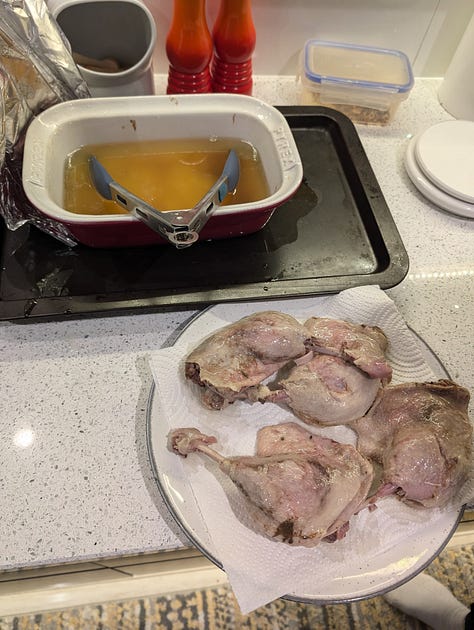We’re riding a rollercoaster this March. Whenever there's a chance, I've been plunging my face into the sun and soaking in the warmth, but reeling as soon as the shade hits because it's not actually summertime and is still, in fact, pretty bloody cold. But, we've just got to ride it out. It's Ronan Keating's world baby, and we're just living in it. The sun will be back.
The silver lining to these annoyingly persistent clouds is that we can all continue to enjoy cold weather food as if there aren’t blossoms creeping onto the trees and those pesky birds aren’t twittering away at dawn. It could still be winter if you close your eyes and imagine. We must insulate! And that means fat.
Confit isn't generally the first choice cooking method of the home cook because it is essentially poaching (i.e. submerging) in fat. Not the cheapest choice; not in this economy1. Garlic confit did the rounds of Foodstagram a couple of years ago - lots of cheery people in shiny kitchens smearing soft golden garlic onto perfected toasted toast. Undoubtedly delicious but who’s really got a few hundred millilitres of olive oil to burn these days2? Those who confit are showing off a bit (or swimming in oil like some sort of Roman goddess / oil empire heiress).
But, I vowed I would learn new skills, and so I make this noble sacrifice for the sake of my education. There were four duck legs in the reduced section and that would surely balance out the cost of the additional fat?! I hate the term girl math but admit this is a prime example of deb math. Other examples include that time I bought fancy double cream to make butter, despite it costing the same if not more as butter and taking infinitely longer to get the ‘butter’ from shop to gob.
Confiting duck is traditionally a preservation method as the meat is rubbed with salt and cooked slowly in the fat, killing off any bacteria and keeping the resulting meat safely away from air exposure. A serendipitous side effect is beautifully soft meat that transports you to a sultrily lit French bistro in the late 20th century. Your troubles don't exist in that French bistro.
Strictly speaking you should confit duck in duck fat, but decent quality oil does the job too. The leftover fat, a resulting mix of oil and rendered duck fat, can be used again for excellent roast potatoes or (not tried this but just had a brainwave) very rich mayonnaise3. I used the method from Great British Chefs to get the timing/temperature right, but you can't go far wrong if you rub the legs with a decent amount of salt and some thyme, leave for a couple of hours, rinse and dry, then cover with fat and cook in the oven, low and slow, for about six hours.



Obviously, it was really good. I crisped up the skin in a pan and served with mash and leftover gravy (always store leftover gravy for emergency use). The original menu was lentils rather than mash in an effort to eat a more balanced diet, but if you're going to do something you might as well whole-ass it. Soon it will be summer salad season.
This week does feel like a genuine effort towards haute cuisine, but if we're being honest the difficulty rating is fairly low. I'd promise to step it up next week but - gasp - I may actually be in a new house by then. And the stove was labelled potentially dangerous by the inspector so probably best not to try anything too advanced in the first instance. But still, it will be my dangerous stove, in my old kitchen without any safe ventilation, in my house!4
Yours in potentially risky cooking conditions,
Deb
Skills: confiting (not sure if that’s a word but onwards we go)
Recipe: confit duck legs
Sources: Great British Chefs - How to Confit a Duck Leg
Or any others.
Figuratively, of course.
Going to try this and make a crispy duck caesar salad because everything about it sounds great.
Sorry - our house. We're both at risk. Huzzah!




